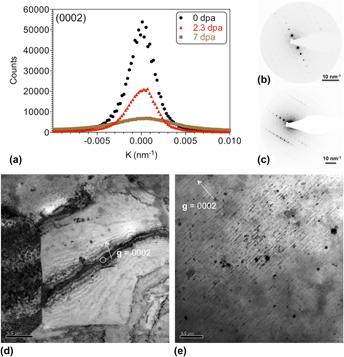Crossref Citations
This article has been cited by the following publications. This list is generated based on data provided by
Crossref.
Burr, P.A.
Wenman, M.R.
Gault, B.
Moody, M.P.
Ivermark, M.
Rushton, M.J.D.
Preuss, M.
Edwards, L.
and
Grimes, R.W.
2015.
From solid solution to cluster formation of Fe and Cr in α -Zr.
Journal of Nuclear Materials,
Vol. 467,
Issue. ,
p.
320.
Saidi, P.
Dai, C.
Power, T.
Yao, Z.
and
Daymond, M.R.
2017.
An embedded atom method interatomic potential for the zirconium-iron system.
Computational Materials Science,
Vol. 133,
Issue. ,
p.
6.
Yu, Hongbing
Liang, Jianlie
Yao, Zhongwen
Kirk, Mark A.
and
Daymond, Mark R.
2017.
Effect of heavy ion irradiation on thermodynamically equilibrium Zr-Excel alloy.
Journal of Nuclear Materials,
Vol. 488,
Issue. ,
p.
33.
Seymour, T.
Frankel, P.
Balogh, L.
Ungár, T.
Thompson, S.P.
Jädernäs, D.
Romero, J.
Hallstadius, L.
Daymond, M.R.
Ribárik, G.
and
Preuss, M.
2017.
Evolution of dislocation structure in neutron irradiated Zircaloy-2 studied by synchrotron x-ray diffraction peak profile analysis.
Acta Materialia,
Vol. 126,
Issue. ,
p.
102.
Harte, Allan
Griffiths, Malcolm
and
Preuss, Michael
2018.
The characterisation of second phases in the Zr-Nb and Zr-Nb-Sn-Fe alloys: A critical review.
Journal of Nuclear Materials,
Vol. 505,
Issue. ,
p.
227.
Watanabe, Hideo
Takahashi, Katsuhito
Yasunaga, Kazufumi
Wang, Yun
Aono, Yasuhisa
Maruno, Yusaku
and
Hashizume, Kenichi
2018.
Effects of an alloying element on a c-component loop formation and precipitate resolution in Zr alloys during ion irradiation.
Journal of Nuclear Science and Technology,
Vol. 55,
Issue. 10,
p.
1212.
Topping, Matthew
Harte, Allan
Frankel, Philipp
Race, Christopher
Sundell, Gustav
Thuvander, Mattias
Andrén, Hans-Olof
Jadernas, Daniel
Tejland, Pia
Romero, Javier E.
Darby, Edward C.
Dumbill, Simon
Hallstadius, Lars
and
Preuss, Michael
2018.
Zirconium in the Nuclear Industry: 18th International Symposium.
p.
796.
Topping, M.
Harte, A.
Ungár, T.
Race, C.P.
Dumbill, S.
Frankel, P.
and
Preuss, M.
2019.
The effect of irradiation temperature on damage structures in proton-irradiated zirconium alloys.
Journal of Nuclear Materials,
Vol. 514,
Issue. ,
p.
358.
Onimus, Fabien
Doriot, Sylvie
and
Béchade, J.-L.
2020.
Comprehensive Nuclear Materials.
p.
1.
Eriksson, J.
Sundell, G.
Tejland, P.
Andrén, H.-O.
and
Thuvander, M.
2021.
An atom probe tomography study of the chemistry of radiation-induced dislocation loops in Zircaloy-2 exposed to boiling water reactor operation.
Journal of Nuclear Materials,
Vol. 550,
Issue. ,
p.
152923.
Ungár, Tamás
Ribárik, Gábor
Topping, Matthew
Jones, Rebecca M. A.
Dan Xu, Xiao
Hulse, Rory
Harte, Allan
Tichy, Géza
Race, Christopher P.
Frankel, Philipp
and
Preuss, Michael
2021.
Characterizing dislocation loops in irradiated polycrystalline Zr alloys by X-ray line profile analysis of powder diffraction patterns with satellites.
Journal of Applied Crystallography,
Vol. 54,
Issue. 3,
p.
803.
Hulse, R.
and
Race, C.P.
2021.
An Atomistic Modelling Study of the Properties of Dislocation Loops in Zirconium.
Journal of Nuclear Materials,
Vol. 546,
Issue. ,
p.
152752.
Preuss, Michael
2021.
Zirconium in the Nuclear Industry: 19th International Symposium.
p.
44.
Ungár, Tamás
Frankel, Philipp
Ribárik, Gábor
Race, Christopher P.
and
Preuss, Michael
2021.
Size-distribution of irradiation-induced dislocation-loops in materials used in the nuclear industry.
Journal of Nuclear Materials,
Vol. 550,
Issue. ,
p.
152945.
Bowman, J.
Wang, P.
Was, G.S.
Bachhav, M.
and
Motta, A.T.
2022.
Ion irradiation induced amorphization of precipitates in Zircaloy.
Journal of Nuclear Materials,
Vol. 571,
Issue. ,
p.
153988.
Bouchareb, I.
Chettah, A.
Bidyadhar, D.
Siva, V.
Sedrati, C.
and
Sahoo, P.K.
2022.
Solubility enhancement and Au-Ni bimetallic alloy formation in immiscible Au/Ni multilayers by ion irradiation.
Nuclear Instruments and Methods in Physics Research Section B: Beam Interactions with Materials and Atoms,
Vol. 516,
Issue. ,
p.
38.
Kumar, Ankit
Singh, S. K.
Kumar, Pravin
and
Dhaliwal, A. S.
2022.
Structural, morphological, and phase transformation studies of 1.4 MeV Kr ion beam irradiated zirconia thin films.
Journal of Materials Research,
Vol. 37,
Issue. 21,
p.
3547.
Eriksson, J.
Sundell, G.
Tejland, P.
Andrén, H.-O.
and
Thuvander, M.
2022.
Nanoscale chemistry of Zircaloy-2 exposed to three and nine annual cycles of boiling water reactor operation — an atom probe tomography study.
Journal of Nuclear Materials,
Vol. 561,
Issue. ,
p.
153537.
Ungár, Tamás
Ribárik, Gábor
Balogh, Levente
Thomas, Rhys
Koc, Omer
Preuss, Michael
Race, Christopher P.
and
Frankel, Philipp
2024.
Fractional densities and character of dislocations in different slip modes from powder diffraction patterns.
Journal of Nuclear Materials,
Vol. 589,
Issue. ,
p.
154828.



